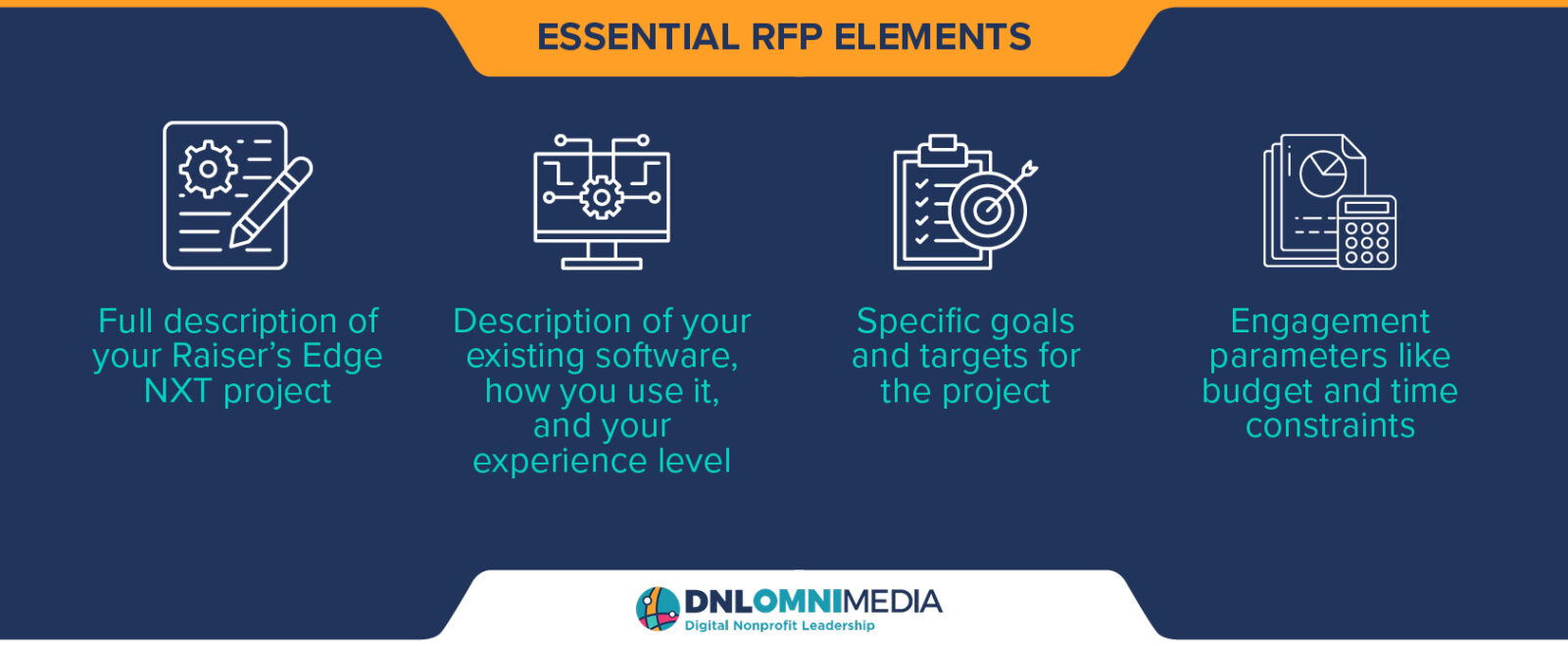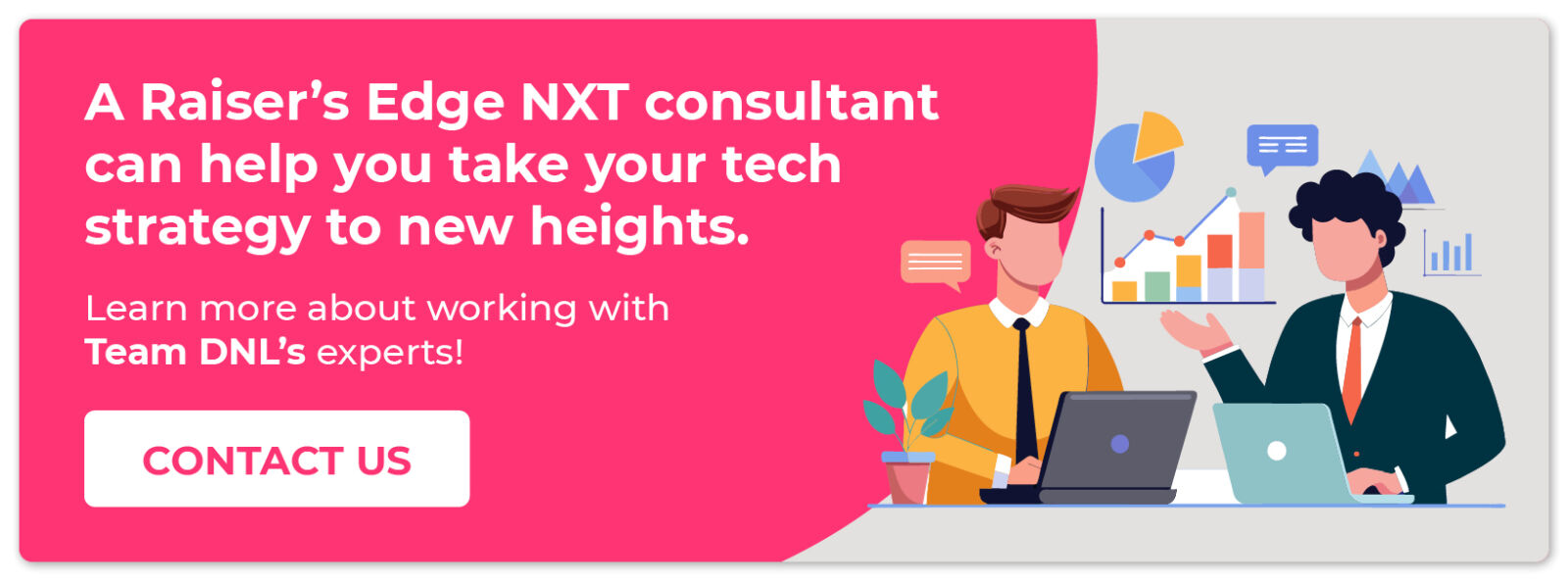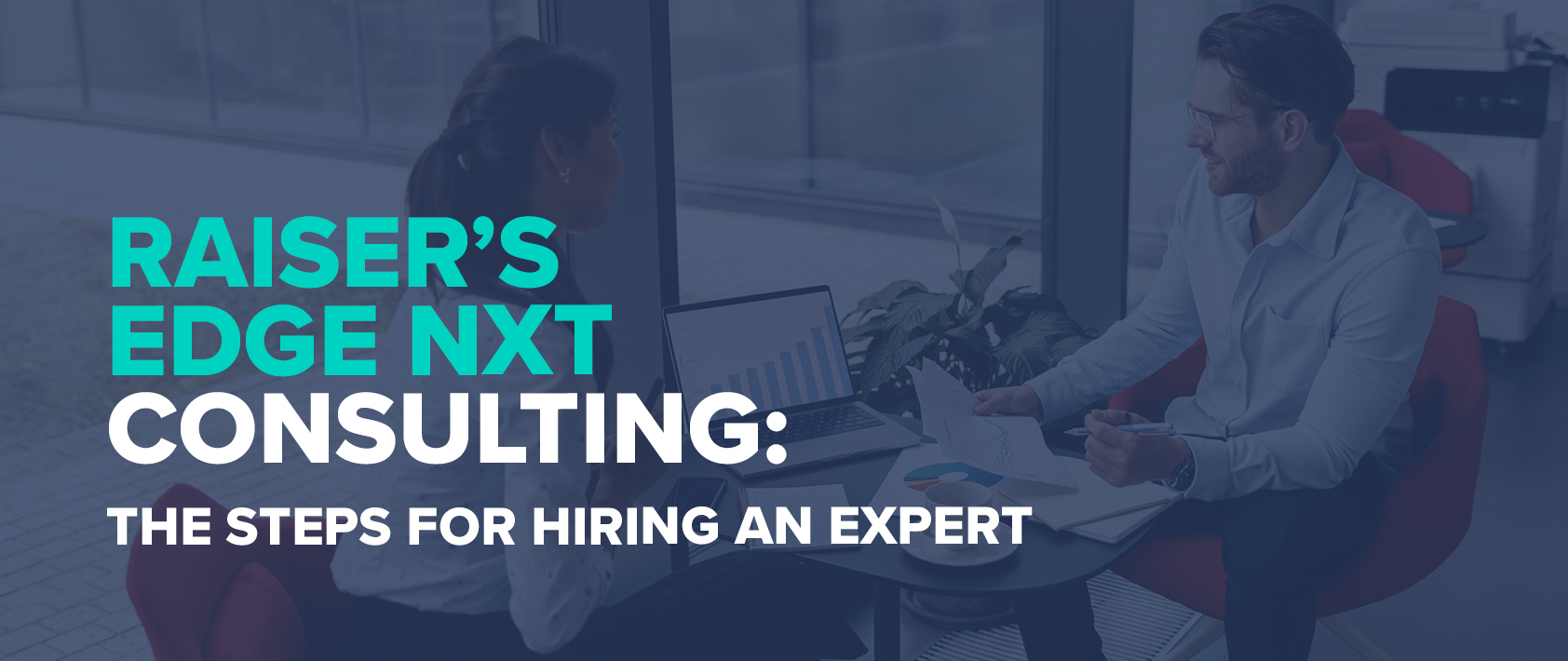Raiser’s Edge NXT is one of Blackbaud’s most popular platforms, providing nonprofits with flexible, out-of-the-box fundraising and donor management tools. After purchasing their software, nonprofits should look into working with a Raiser’s Edge NXT consultant.
Blackbaud partners familiar with Raiser’s Edge NXT can help nonprofits configure their platform, receive comprehensive training, and develop custom software and integrations. When hiring a Raiser’s Edge NXT consultant, your team should adhere to these best practices:
- Outline the specifics of your Raiser’s Edge consulting project.
- Develop your RFP.
- Explore the candidate’s services related to Raiser’s Edge NXT.
- Research their past experiences and references with Raiser’s Edge.
- Rank your top Raiser’s Edge NXT consulting candidates.
Hiring any type of nonprofit consultant requires careful consideration to make the most of your nonprofit’s new investment. A consultant that your team works well with has the potential to not only see through your initial implementation but become a reliable resource for future projects and ongoing technical needs.

1. Outline the Specifics of Your Raiser’s Edge NXT Consulting Project
Before partnering with a consultant, your nonprofit should establish what you want your project to accomplish. While you may need to work with your consultant to finalize a few details, outlining your project’s basic parameters will help narrow your search for the right consultant.
When planning consulting projects for platforms like Raiser’s Edge NXT, it is crucial to prioritize data strategies, timelines, and budgets.
- Data cleanup and migration strategy. Implementing Raiser’s Edge NXT for the first time, adopting new custom integrations, or running major updates requires careful thought about how best to manage your data during this process. For instance, if you need support implementing the platform, inform your consultant how much existing data will be migrated over into it. The data strategy they develop will most likely involve a cleanup process as well to ensure your system is as streamlined as possible.
- Timeline. How long will your Raiser’s Edge NXT project take? Are there any upcoming major campaigns that your timeline will be affected by or built around? Your answers might also depend on whether your team requires additional training. Plan for setbacks and consider what aspects of your project you may need assistance with in the future. For example, consider working with a consultant who provides long-term training support to help you quickly get new employees up to speed with your software.
- Budget. Determine a budget by factoring in your consulting fees and the cost of the software itself. While consulting services may seem expensive in a void, keep in mind that they are comparably cheaper than hiring a new team member to handle your project internally. This is especially true in the case of consultants who provide ongoing maintenance and support and can become an extension of your organization.
To determine these specifics, work with team members across different departments at your nonprofit. Be conscious that you may need to adjust your expectations as your project continues and work with your consultant to create alternative plans if you experience a setback.
2. Develop Your RFP
Once you know the scope of your project, you can begin developing a request for proposal (RFP). An RFP is a document you will share with consultants that provides details about your project and requests a proposal for how they would go about completing that project.
An RFP for a nonprofit technology consulting project will typically include a few common sections. Make sure yours contains:

- A full description of your intended Raiser’s Edge NXT project
- A description of your existing software, how your team uses it on a daily basis, and their level of experience with Raiser’s Edge NXT
- Your specific goals and concrete targets for the project, as determined in the previous step
- The concrete parameters you’ve identified, namely the project’s budget and time constraints
When drafting your RFP, develop criteria for how you will evaluate responses. Recruit members of your team from different departments to help with your assessment to ensure you choose a consultant who will provide value to your nonprofit as a whole.
While each nonprofit will give different weight to different criteria, a few common points of assessment for consultants are:
- The consultant’s level of experience with organizations like yours
- The difference between their proposed cost and your budget
- Their availability for extended or periodic training and support
Be open to answering any additional questions that the consultant may have about your project. Plan to give consultants a few weeks to respond to your RFP before making your final evaluation.
3. Explore Candidates’ Services Related to Raiser’s Edge NXT
After establishing the goals and scope of your project, begin researching consultants who specialize in Raiser’s Edge NXT. As a flexible, highly customizable platform, consultants familiar with the Raiser’s Edge NXT will offer a variety of services related to the solution.
The main areas of support a consultant can help guide your nonprofit in are:
- Implementation. Implementation services include managing your data migration and configuring your Raiser’s Edge NXT platform to address your organization’s specific needs.
- Custom development. Custom development typically involves integrating Raiser’s Edge NXT with existing tools, like your website, fundraising software, or other technology. For some nonprofits, it may also include developing new features and customizing the platform’s existing tools.
- Fundraising strategy. Raiser’s Edge NXT is a comprehensive platform that helps you fundraise and manage your donor data in smarter ways. A consultant can help you develop fundraising plans to make the most of your new software.
- Training. Your team should fully understand your new technology’s full range of features and how to use them. A consultant can ensure everyone is on the same page without overwhelming the team as a whole. Consultants can also help provide training documentation that can be shared with team members who are hired after your initial training sessions.
- Ongoing support. Your nonprofit will likely need assistance with your platform after implementation. Partner with a consultant who offers ongoing support and provides services like website monitoring, routine annual analytics and reports, and additional training services. Additionally, if you ever encounter a technical issue, you can resolve it quickly by reaching out to a consultant who is already familiar with your nonprofit’s technology.
When assessing consultants, look for firms that specialize in the entire Blackbaud suite, rather than just Raiser’s Edge NXT. These consultants will have a strong understanding of the nuances of Blackbaud products and may even have custom purpose-built solutions that you can quickly and easily implement. For example, DNL OmniMedia’s Blackbaud-related products include Blackbaud-integrated mobile apps, TeamRaiser extensions, and Luminate Online add-on modules.
Once you have assembled a list of top candidates, you can make initial contact. When first reaching out, do not submit your RFP upfront. Instead, introduce your nonprofit, discuss the types of services you are interested in, and ask any questions you might have about their offerings.
After the consultant responds to your introduction and provides additional context about their services, you can determine whether to submit an RFP. Some consultants have more formal processes for submitting an RFP and ask potential clients to complete a specific form, whereas others may simply accept an RFP in the body of an email.
4. Research Their Past Experiences and References with Raiser’s Edge NXT
As you build and refine your shortlist of prospective consultants, it’s essential to get a concrete sense of their abilities and experience. Reach out to your top candidates to discuss their past projects and request references. Give the consultants a few days to contact their references and let them know that you will be reaching out to them to improve your response rates.
Get in touch with nonprofits who received assistance with projects similar to yours. Ask them about the consultant’s process, the project’s outcomes, if they were able to stick to the outlined budget and timeline, and if they are still satisfied with the work the consultant completed.
Ask questions about both the consultant’s technical expertise and the working relationship they cultivate with clients. Essentially, your goal is to answer two questions:
- Is the consultant capable of completing my project in a timely manner?
- Will my nonprofit be able to collaborate with the consultant successfully?
If a reference’s feedback casts doubt on either of these questions, first reassess the reference’s project. If they had notably different goals or a different type of project, some feedback related to technical expertise may be less relevant to your project.
However, keep their assessment in mind when reviewing your RFP responses. Feedback provided by references might highlight strengths and weaknesses in RFPs that you may not have initially considered as closely.
5. Rank Your Top Raiser’s Edge NXT Consulting Candidates
After receiving your proposals, use your previously established criteria to assess them. Recruit a range of stakeholders to help review your proposals and create a standardized assessment form to make sure your entire team brings their own perspectives but also uses the same criteria.
Consider weighing various elements of your criteria based on their importance. For example, if a nonprofit is tight on resources, they might create a 100-point system and put 40 points into budget, 25 into technical expertise, 15 into work strategy, and 20 into long-term sustainability. This breakdown reflects this nonprofit’s priorities of managing its current resources and planning for the future.
Start your assessment by outright eliminating candidates whose proposals do not align with your goals. Then, remove candidates who do not meet your criteria or come up short in important areas. Finally, re-evaluate your top candidates, keeping your goal, target deliverables, and parameters in mind.
When you have chosen your top consultant, reach out to them to finalize your partnership and begin your Raiser’s Edge NXT project.
Raiser’s Edge NXT consulting can ensure that your organization is positioned to make the most of your investment in this reliable, flexible platform. Have a conversation with Team DNL today so we can help you find the right partner for the job.
If you need more assistance finding a consultant, try exploring these resources:
- Blackbaud Partners for Your Nonprofit: 10 Top Picks. Find potential Raiser’s Edge NXT consultants by exploring the top Blackbaud partners for nonprofits.
- Nonprofit Technology Consulting: 6 Steps to Success. After partnering with your consultant, you can begin working alongside them to complete your project. Learn how to plan and execute a project while working with a consultant in this guide.
- Nonprofit Consulting Firms: 27 Leaders in Their Spaces. Nonprofit consultants offer a variety of other services in addition to technology. Explore these leading consulting firms to receive support for marketing, capital campaigns, website development, and more.


